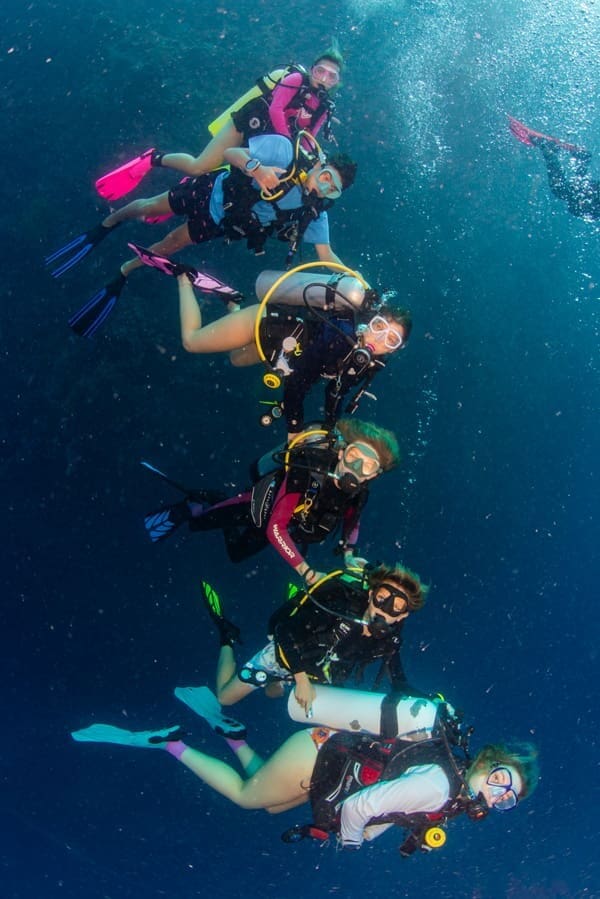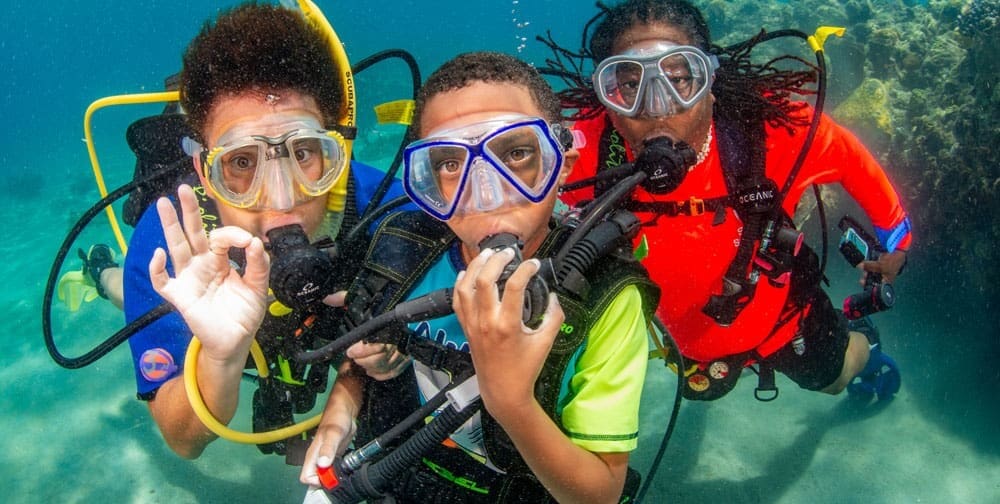Inspiring the next generation of divers
A scuba instructor’s philosophy when teaching kids to scuba dive.
Hello, My name is Margo Peyton. I have enjoyed teaching kids about the underwater world for 25 years. My philosophy as a scuba instructor when teaching kids is to inspire an appreciation and respect for our underwater world. I proactively share my joy, love, and understanding of the fragile marine environment they have committed to learning about. Scuba instructors are similar to other educators, coaches, and adventure guides. We have the transformative power to change a life for the better daily, one family at a time.

I must remember that in today’s world, the effort made by my students’ parents to navigate access to scuba diving experiences for their children can be costly and challenging. As an instructor who teaches in the most desirable dive destinations around the globe, I try to make sure that I am welcoming and attentive to each student as they arrive nervous, excited, and hungry to embark on the journey of becoming a diver.
There are a few good points I’ve learned along the way when diving and teaching kids.
1. Share your passion with your students: Tell them what you love about diving and why. I like to talk about zero gravity, being present in the moment, and being able to leave the surface of my busy world behind.
2. Go Slow: Tell them what you’re going to tell them, Tell them, and then tell them what you told them. Use analogies that will inspire and interest kids or make them laugh. Slow down your briefing and add some personal, friendly touches or experiences. Give plenty of time for Q&A. Go slower when demonstrating, descending, guiding, and ascending.
3. Those Tiny Little Ears: Most kids have no idea what equalizing feels like when learning to dive. They have shorter eustachian tubes than adults. I explain to kids what it feels like when landing in an airplane because all my students experience this when flying. So they get that analogy. I also explained that when they chew gum or swallow in the plane, they equalize the pressure in their ears, and I showed them how to do that with gentle pressure, holding their noses, wiggling their jaws, etc. I see the light bulb click in their eyes at that moment of understanding. It’s crucial to descend slowly, use a line to help them with this process, and over-emphasize pain as a complete stop. I could do a full story on ears, but most importantly, it can take up to 10 minutes for some kids to descend as young divers safely.
4. Instructors can and should Ask for assistance when needed: If you have not taught kids or don’t do so very often, ask for a certified helper. Students should never be left alone for any reason, and kids need more attention and time than adult divers. They must be reminded to stay hydrated, apply sunblock, have a shorter time between breaks, and have additional assistance carrying and setting up heavy gear. I have a comfort level with no more than two kids at a time, so that is my ratio as an instructor. One hand for each child. If I have three or more, I ask for assistance.
5. Stay super Close: Staying close to kids! This means being able to reach out and touch them. It means understanding that kids can be like mosquitos underwater. They can move fast, love zero gravity, and fly in any direction. Kids are wowed and distracted by the colors, fish, and each other. They love exploring how fast or slow they move underwater and enjoy being upside down and doing somersaults. I advise you to stay close enough for them to contact you when needed. I like my students close enough to hold on to during training dives, current dives, first-time night dives, and wall dives.
6. Create Good Communication: It’s fun to communicate with kids underwater and teach them about marine life. I always have slates for drawing with them; I enjoy their writing and communicating with me now, as kids need to do. I have a quick-release clip to share my Scubapro wet notes book and pencil with my students. I love their drawings of a fish they want to ask me about later and reviewing their questions that tell a story of their dives. I love teaching signs and signals to kids and letting them create new ones to share with their parents. This is one of the most excellent tools to give kids and parents. Once they start diving together, writing notes can create bonds, preserve memories, and relieve stress.
7. Ask your students questions: Building trust and getting to know your students a little better can make a difference in your dive. I ask how they feel and what they are excited to learn and see today. I ask multiple times if they are too cold, hungry, or hot. I ask if they are nervous and comfortable. I brief and debrief and then ask if they have any questions and make sure they feel every question is essential and answered.
8. Be Patient and allow more time for everything: I run a junior open water class at every Kids Sea Camp as a week-long course. If you’re used to teaching adults, when teaching kids, get out of your head and ensure that everything runs smoothly, efficiently, and as planned. Then, you can make learning fun, take your time, and create memories to last a lifetime with kids.
9 Turn around and have eyes on your students at all times: This is the one thing I find myself teaching and advising instructors the most. You could not take kids to a mall, carnival, or fair and walk in front of them for more than 2 min and not turn around and expect them to be following behind you. The underwater world is like a giant aquarium full of fantastic aliens and critters to be memorized by. The corals and walls and water are all distractions. Kids need constant oversight. My best instructors dive backward for the majority of the dive. You are too far away if you can not see each child’s eyes clearly.
10: #1 question you will have to answer: Why repeatedly? Be prepared to answer this question in detail and often. Think about giving positive, inspiring, and safety-conscious answers. Why do I have to take my mask off? Why do I have to wear a wetsuit? Why do I have to wear a snorkel? Why can’t I touch that fish? Why can’t I dive deeper? These questions must be answered with care, patience, and thoughtfulness. Try not to give answers that will scare kids.
Most importantly, with kids, you can be the person who changes their lives, inspires their passion, and forever changes their love of the ocean. You are creating a memory that will last a lifetime and have a lasting effect on someone’s world that you may never know about. So make it a positive change.
Margo Peyton Family Dive Adventures Dive Travel and Kids Sea Camp Inc (Our mission)

